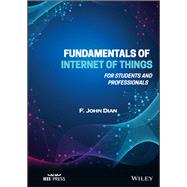Fundamentals of Internet of Things: For Students and Professionals teaches the principles of IoT systems. It employs a systematic approach to explain IoT architecture models and their layers. The textbook is arranged based on various layers of an architecture model. For readers who are unfamiliar with the concept of data communication and networks, the first chapter of this book covers the fundamentals of data communication and networks. It can also be used as review material for those who are already familiar with the concept.
The book begins with many examples of IoT use cases to show readers how IoT can be applied to various IoT verticals. The concept of smart sensors is then described, as well as their applications in the IoT ecosystem. Because internet connectivity is an essential part of any IoT system, the book explores wired and wireless connectivity schemes including cellular IoT in the 4G and 5G eras. IoT protocols, analytics, as well as IoT security and privacy are important topics that are explained in this book with simple explanations. The last chapter of this book is dedicated to IoT solution development. IoT is one of the most rapidly evolving technologies today, and there is no better guide to this rapidly expanding sector than Fundamentals of Internet of Things (IoT) for Students and Professionals.
Features:
- Simple explanations of complex concepts
- More than 300 exercise problems and advanced exercise questions
- Provided solutions for the exercise problems
- 10 practical IoT projects








